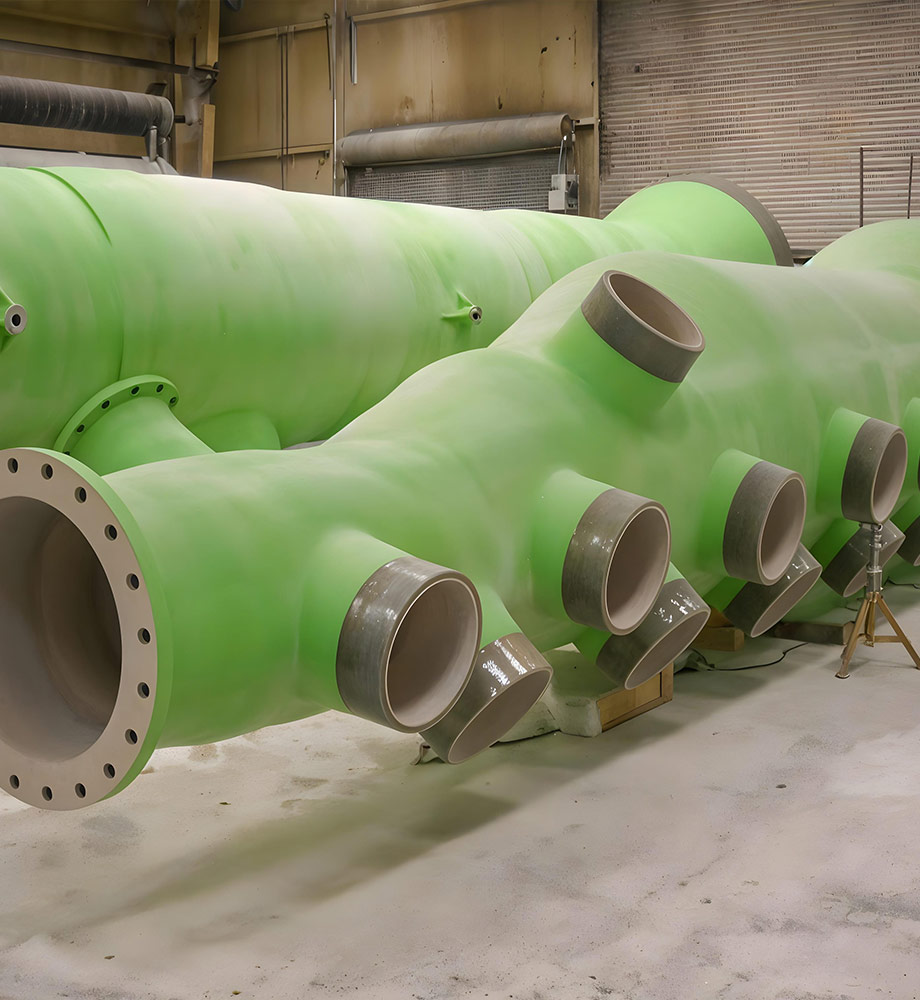Key Features
- Corrosion-Resistant Fabrication: FRP headers use the same glass/polymer composite as the piping, so they resist acids, alkalis and salts on all wetted surfaces. No lining or special coatings are required.
- Multiple Outlet Configurations: Can be built as tees, crosses, or custom “Tee blocks” connecting several branches. Manufacturers often fabricate one-piece laminate blocks with multiple drilled ports for zero-leak performance.
- Lightweight Assembly: Even large-diameter FRP headers are much lighter than equivalent metal manifolds, making installation and alignment easier.
- Integral Pipe Supports: FRP headers can be supplied with attached supports or saddles that distribute weight and simplify alignment to the piping layout.
Benefits
- Uniform Flow Distribution: Smooth, welded FRP branching minimizes pressure drop imbalances between parallel lines.
- Simplified Piping Layout: One FRP header replaces many individual branches and valves, reducing joint count.
- Maintenance-Free Service: No risk of header corrosion means valves and flow controllers downstream see clean fluids, extending their life.
- Custom Engineering: Headers can incorporate multiple functions (flow splitter, mixing header, distribution block) in one module, saving space and assembly time.
Applications
FRP headers/manifolds are used wherever a main process line splits into several branches with corrosive fluids. This includes chemical dosing skids (header feeding multiple reactor inlets), scrubber ring mains (distributing acid streams to multiple spray nozzles), boiler feed or condenser cooling (sharing cooling water among units), and process sample systems. They appear in water treatment plants (collecting flows from multiple clarifiers), plating lines (common header to multiple tanks), and HVAC/chiller systems handling glycols or salts. Any large plant with parallel piping runs (e.g. multiple scrubbers or columns) can benefit from FRP manifold blocks to simplify the plumbing.
Technical Specifications
- Construction: Usually fabricated by filament winding or contact molding over FRP pipe or custom mandrels. Flanged outlets match the pipe schedule (ANSI/DIN etc.).
- Ports: Outlet sizes and angles tailored to application (standard e.g. 1×3, 2×2 arrangements or custom multi-hole patterns). Connection types are typically flanged, but can also be o-ring sealed joint (O-ring grooves can be built in).
- Liner Options: If highly aggressive fluids are present, the entire header or just its wetted side can incorporate a plastic liner (similar to TL-FRP pipe), ensuring complete containment of the fluid.
- Pressure Rating: Equal to the FRP pipe used (up to ~60 bar for standard FRP, higher if epoxy/GRE is used). Usually tested hydrostatically at 1.5× operating pressure.
Unique Selling Points (USPs)
- One-Piece Header Assemblies: Leading FRP fabricators offer monolithic header blocks (pultruded or molded) that eliminate flanged joints between the main and branch runs. This “no joint” construction mirrors the superior quality of FRP piping and prevents leaks at high pressures.
- High Corrosion Integrity: Unlike metal manifolds, FRP headers never rust. Their joints (often bonded FRP or gasketed resin flanges) remain leak-tight without costly coatings.
- Versatility: Headers can be skidded or supported on frames and shipped ready to bolt in. They can house monitoring ports, instrumentation or dampers in a single assembly.
- Flow Control Integration: FRP headers often integrate combination valves or flowmeters at each branch port, providing compact, corrosion-proof distribution packages that competitors (with metal headers) can’t match in longevity.

